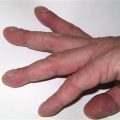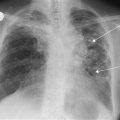Axillary Swellings
The great majority of axillary swellings are enlarged lymph nodes. Axillary nodes are often enlarged due to secondary deposits from carcinoma of the breast. Most axillary swellings are easily diagnosed on clinical examination alone.
History
Superficial
Acute abscess
This presents as a tender swelling in the skin. There may be a purulent discharge. Common in diabetics.
Sebaceous cyst
A sebaceous cyst will present as a firm swelling in the skin, often with a punctum. It may be tender if it becomes inflamed and there may be discharge from it.
Lipoma
This presents as a soft, lobulated swelling in the subcutaneous tissue.
Deep
Lymphadenopathy (p. 321)
The patient may have noticed a lump in the axilla, which may be tender or non-tender. Check for a site of infection or malignancy in the region of drainage of the nodes, i.e. the arm, the chest wall and the abdominal wall as far down as, and including, the umbilicus, the skin of the back as far down as the iliac crest and the breast. Has the patient noticed any lumps elsewhere? Check for malaise, pyrexia, night sweats, cough. There may be a history of bruising or epistaxis to suggest a blood dyscrasia. Is there any evidence of scratches on the arm to suggest cat scratch disease?
Breast lumps
Occasionally a lump in the medial wall of the axilla may be a swelling in the axillary tail of the breast, e.g. fibroadenoma or carcinoma.
Lipoma
Occasionally the patient may notice a firm swelling which appears intermittently, slipping out from under cover of the muscles.
Chronic abscess
Check for a history of TB. There may be night sweats.
Axillary artery aneurysm
This is rare. The patient may notice a pulsatile swelling under the arm. When the swelling becomes large, the patient may notice the arm moving away from the side of the body with each heart beat. Occasionally there may be symptoms in the hand due to distal embolisation.
Examination
Superficial
Acute abscess
There may be a tender, red, fluctuant swelling with purulent discharge.
Lipoma
There will be a soft, lobulated swelling in the subcutaneous tissue.
Sebaceous cyst
A small, well-defined swelling in the skin. A punctum may be visible. If it is infected, the surrounding skin will be red and the lesion tender. Discharge may be present.
Hidradenitis suppurativa
Multiple tender swellings with surrounding erythema and discharge of pus are present.
Deep
Chronic abscess
A fluctuant swelling presents in the axilla. With TB, there may be little or no signs of inflammation.
Lymphadenopathy
Single discrete node, e.g. lymphoma. Numerous hard nodes or matting of nodes (carcinoma). Tender fluctuant nodes (abscess). Check for infection or tumour in the area of drainage of the lymphatics. Examine the breast. Check all other sites of nodes, e.g. cervical, inguinal; check for hepatosplenomegaly.
Lipoma
Deep lipomas are usually intermuscular and may be felt only in certain positions. They may slip in and out between the pectoral muscles. They may be firmer and not have the lobulated feel of a more superficial lipoma.
Axillary artery aneurysm
A pulsatile mass will be palpable within the axilla. Check the distal circulation. If an axillary artery aneurysm is large, when the patient stands with the arms by the sides, the arm moves away from the side of the body as the lump pulsates.
Breast lumps
A lump on the medial wall of the axilla may be a lump in the axillary tail of the breast.





